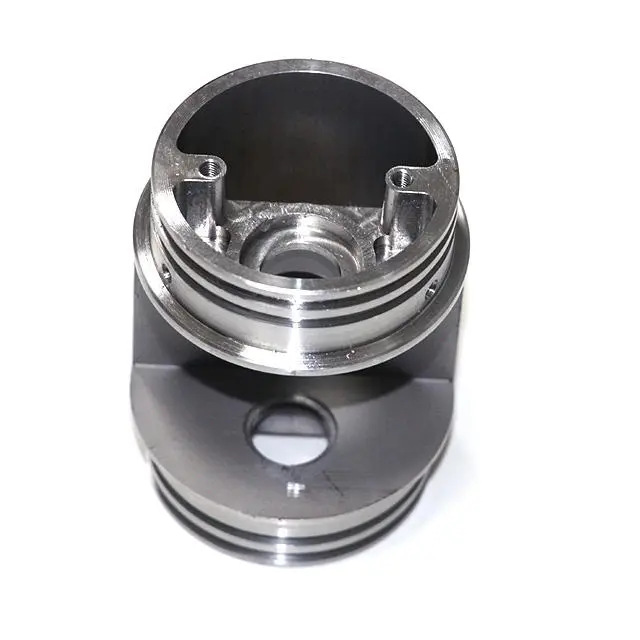
- +8615586668226
- [email protected]
- رقم 30، حديقة هونغبانغ الصناعية، شينزين

Cloud-based Computer Numerical Control (C-CNC) represents a paradigm shift in manufacturing. In simple terms, it moves the “brains” of CNC machines, the functionalities, to the cloud. Think of it like this: instead of having a powerful computer directly connected to each machine, the heavy computational tasks are performed remotely on powerful cloud servers. These cloud servers then send instructions to the manufacturing machines, like 3D printers, as a service.
This approach offers several advantages. First, it allows manufacturing machines to utilize advanced control algorithms. These algorithms, often too complex for local controllers, can significantly boost machine performance without needing expensive hardware upgrades. Second, C-CNC enables a pay-as-you-go model. Businesses only pay for the CNC functionalities they need, reducing costs significantly. Third, upgrading becomes easier. With the control logic residing in the cloud, updates are streamlined, minimizing downtime and avoiding frequent, costly hardware overhauls.
C-CNC isn’t just about cost savings; it’s about unlocking superior performance. By leveraging the cloud’s computational power, 3D printers can achieve higher speeds and greater accuracy. Traditional local controllers often struggle with complex algorithms. But with C-CNC, advanced algorithms, like sophisticated motion control and vibration compensation, become feasible.
For instance, consider a 3D printer. With a cloud-based controller running a jerk-limited motion command generator and a vibration compensation algorithm, the printer can reach accelerations of up to 10 m/s². This is a substantial improvement compared to the 0.5 m/s² limit of a typical local controller without serious quality degradation. This translates to faster printing times, higher throughput, and ultimately, better productivity. For example, a cloud-based controller can reduce printing time for a complex part like a Medieval Castle model by over 50% compared to a standard local controller.
While C-CNC offers immense potential, sending real-time control signals over the internet poses challenges. The internet, by its nature, can introduce delays, data packet loss, and other quality-of-service issues. Imagine controlling a machine remotely and experiencing a lag. It’s like trying to play a high-speed video game with a slow connection – frustrating and unproductive. These issues can lead to safety concerns and impact the reliability of the manufacturing process.
For 3D printing, these delays can manifest as pauses during the print. The printer might run out of instructions, leading to uneven surfaces, imperfections, and even failed prints. For example, experiments have shown that high latency internet connections can cause blobs to appear on the surface of printed parts, as seen when comparing prints from different geographical locations with varying network qualities.
One effective way to combat the challenges of internet latency is to reduce the amount of data transmitted. Smaller data packets are less susceptible to delays and more likely to arrive on time. This is where data size reduction techniques come into play. By transmitting less data, we increase the efficiency of the communication between the cloud controller and the manufacturing machine.
Think of it like sending a letter versus a postcard. The postcard, being smaller, is likely to reach its destination faster. In the context of C-CNC, reducing the data size means the 3D printer receives a steady stream of instructions, minimizing pauses and ensuring a smooth, high-quality print. This approach is particularly crucial for maintaining the reliability of cloud-based control, especially when dealing with high latency internet connections. To illustrate how data is passed, see below table:
| المعلمة | القيمة |
|---|---|
| Motion commands frequency | 1 kHz |
| Data format | Double |
| Data size (before truncation) | 32 KB/s |
| Data size (after truncation) | 9 KB/s |
| Stepper motor commands freq. | 20 kHz |
| Data size | 20 KB/s |
Pseudo-lossless data truncation is a clever technique that reduces data size without sacrificing essential information for control. It’s like summarizing a long document – you keep the key points and discard the rest. This method leverages the physical limitations of the manufacturing machine. For example, a 3D printer has a specific resolution and maximum speed. Any information beyond these limits is essentially redundant.
Truncation works by identifying and removing this redundant data. It focuses on transmitting only the necessary information for accurate control. This is achieved by representing the motion commands in a more compact format, tailored to the printer’s capabilities. In practice, this can lead to a significant reduction in data size, often by more than 50%, without compromising print quality or control accuracy. Here is a simple list of how the truncation scheme works:
Traditional lossless compression methods, like Deflate, BWT, LZMA, PPMd, and Zstandard, are commonly used to reduce file sizes. However, they are not always ideal for real-time control applications like C-CNC. These methods often require significant computational resources for decompression, which can be a bottleneck for resource-constrained devices like 3D printer microcontrollers.
Moreover, while compression can reduce data size, the reduction ratio can vary significantly depending on the data itself. This variability can make it difficult to guarantee consistent performance in a real-time control scenario. Truncation, on the other hand, offers a fixed and predictable data reduction ratio. It’s specifically designed for the task at hand, making it a more reliable solution for C-CNC applications.
| Compression Method | Memory Usage (MB) |
|---|---|
| Deflate | 2 |
| LZMA | 3 |
| BWT | 7 |
| PPMd | 3 |
| Zstandard | 1 |
Implementing data truncation in a real-world C-CNC setup for a 3D printer yields impressive results. Experiments have shown that truncation can eliminate pauses during printing, even with high-latency internet connections. This translates to smoother, higher-quality prints with consistent printing times, regardless of the geographical location of the cloud controller.
For example, printing a calibration cube from locations with high network latency, like Mumbai, Singapore, and Sydney, showed no pauses and consistent print quality when using truncation. This demonstrates the effectiveness of truncation in mitigating the challenges posed by internet latency, making C-CNC a viable and reliable solution for remote manufacturing. This is especially important for industries that require consistent quality, like الأجهزة الطبية manufacturing and الطيران والفضاء المكونات.
The benefits of C-CNC extend across a wide range of industries. In aerospace and aviation, where precision and reliability are paramount, C-CNC can enable the production of complex, high-performance parts with greater efficiency. The السيارات industry can leverage C-CNC for faster prototyping and manufacturing of custom components, accelerating innovation and reducing time-to-market.
الجهاز الطبي manufacturers can benefit from the precision and repeatability offered by C-CNC, ensuring the production of high-quality, reliable medical implants and instruments. The الإلكترونيات industry can utilize C-CNC for the rapid prototyping and production of intricate electronic components. Even السلع الاستهلاكية manufacturers can leverage C-CNC for faster product development cycles and customized product offerings, such as تصنيع الصفائح المعدنية.
Other industries that can benefit from C-CNC include:
C-CNC is just the tip of the iceberg. The future of manufacturing lies in embracing cloud-based solutions. We envision a future where entire factories are connected and controlled through the cloud. This will enable seamless integration of design, manufacturing, and supply chain operations, leading to unprecedented levels of efficiency and agility. The seamless transfer of information between CAD, CAM, and CNC will be possible, further enhanced by cloud integration.
Imagine a world where a design change made in one location instantly updates the manufacturing process across multiple factories worldwide. This is the power of cloud-based manufacturing. It’s about creating a more connected, responsive, and efficient manufacturing ecosystem. This concept will also enable التصنيع عند الطلب as a viable solution for businesses. As a leading CNC manufacturing service, we’re committed to driving this transformation and helping businesses realize the full potential of Industry 4.0.
As a leading CNC manufacturing service and product manufacturing factory, CNC-Fabrication is at the forefront of the C-CNC revolution. We offer a wide range of خدمات التصنيع الآلي و خدمات التصنيع, including CNC milling, turning, 5-axis machining, and precision machining. Our expertise in C-CNC enables us to deliver high-quality, cost-effective manufacturing solutions to businesses across various industries.
We understand the challenges and opportunities presented by C-CNC. Our team of experts can help you implement and optimize cloud-based solutions for your specific needs. Whether you’re looking to improve efficiency, reduce costs, or enhance product quality, we have the knowledge and experience to guide you every step of the way.
How secure is cloud-based manufacturing?
Security is a top priority in cloud-based manufacturing. Reputable cloud providers offer robust security measures, including data encryption, access controls, and regular security audits, to protect sensitive information.
What happens if the internet connection is lost during a print?
While data truncation mitigates the impact of brief interruptions, prolonged internet outages can still pose a challenge. Future solutions may involve redundant local controllers to ensure continued operation during extended outages.
Is C-CNC suitable for all types of manufacturing?
C-CNC is particularly well-suited for applications that require high precision, complex geometries, and remote control. However, its suitability may vary depending on the specific manufacturing process and requirements.
What are the initial costs associated with implementing C-CNC?
The initial costs can vary depending on the existing infrastructure and the specific C-CNC solution implemented. However, the long-term cost savings from reduced hardware requirements, increased efficiency, and pay-as-you-go models often outweigh the initial investment.
How does C-CNC impact the need for skilled labor?
C-CNC doesn’t eliminate the need for skilled labor but rather shifts the focus. While some manual tasks may be automated, there will be an increased demand for professionals with expertise in cloud technologies, data analytics, and advanced control systems.
Can C-CNC be used for mass production?
Yes, C-CNC is scalable and can be adapted for mass production. The ability to control multiple machines from a central location makes it ideal for scaling up manufacturing operations.
Contact us today to learn how we can help you transform your manufacturing processes with C-CNC and unlock new levels of efficiency, quality, and innovation.
العنوان
رقم 30، متنزه هونغبانغ الصناعي، شينزين
البريد الإلكتروني
[email protected]
الهاتف
+86 15586668226
احصل على أحدث الاتجاهات والحقائق حول التصنيع باستخدام الحاسب الآلي من مدونتنا.
شركة Shenzhen Runkey Precision Technology Co. Ltd، وهي شركة تابعة لمجموعة Tensun Group، هي الحل الشامل الموثوق به للتصنيع المخصص بدءًا من النماذج الأولية وحتى الإنتاج، حيث إنها تحول فكرتك إلى واقع ملموس من خلال موارد التصنيع الرقمية، والعمليات المبسطة، وتوجيهات الخبراء، والجداول الزمنية المتسارعة، والجودة التي لا تقبل المساومة.
©2024. التصنيع باستخدام الحاسب الآلي جميع الحقوق محفوظة.